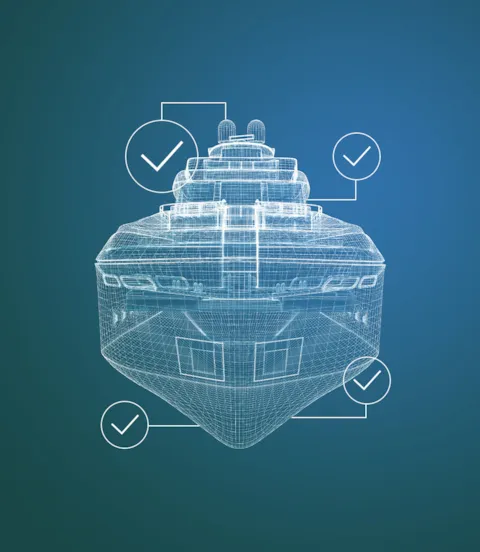Using 3D models to streamline the approval process in the yacht industry
As shipping makes advances in digitalization, the approval process is being made smoother and more streamlined by the use of 3D models. This has raised the interest of stakeholders in the yacht industry.
For the past few decades, approval of vessels, including yachts, has predominantly taken place on 2D drawings. While technological advancements in recent years have resulted in most vessel design being 3D based, traditional approval methods have continued to prevail. A common practice still is for 2D drawings to be extracted from 3D models for approval.
“The obvious next step is to extract the information needed for design approvals directly from these 3D models and perform the entire review process digitally instead of the traditional drawing-based reviews,” says Ole Christian Astrup, Senior Principal Specialist at DNV.
OCX standardization facilitates digital workflow
Following the establishment of a DNV-led Joint Industry Project (JIP) APPROVED in 2016, ship designers, yards and classification societies can now engage in 3D approval through the Open Class 3D Exchange Standard, also known as OCX. Crucially, this enables interoperability across all the different computer-aided design (CAD) applications, overcoming fundamental problems of heterogeneity.
“A wide range of CAD software applications and digital engineering tools are used in design and manufacturing processes, which has created technical challenges, such as data integrity and difficulties with point-to-point integration,” explains Astrup. “OCX solves this issue by effectively acting as a conduit between these platforms, thus standardizing formats and enabling shipbuilders and class societies to review models and engage in a seamless digital workflow.”
3D approval appealing to yacht industry
Deltamarin was one of the first companies to benefit from 3D approval, after DNV approved a 3D model as part of the classification material for Höegh Autoliners’ Aurora Class PCTCs in November 2022. Since then, several DNV partners have shown increased interest in 3D approval, including many from the yacht segment.
“Stakeholders in the yacht segment are usually keen to be at the forefront of technological trends, and several of our clients have expressed an interest in 3D approval recently,” says Martin Richter, Ship Type Expert Yachts at DNV. “This has mainly come from designers and shipyards, who are keen to take advantage of the range of benefits that 3D approval can deliver.”

3D approval saves time and money
Using 3D approval instead of traditional 2D drawings brings many benefits, including savings in time and money for shipyards and designers.
"Most designers and shipyards in the yacht industry use 3D programs in their design process, so they stand to benefit a lot from 3D approval as this will eliminate the need to create some 2D drawings. This will reduce their workloads, thus reducing time to market and – critically – reducing costs," says Richter.

Added quality with 3D approval
“There is also an added quality element with 3D approval,” Richter explains. “You may see details on the 3D platform that aren’t as clear on 2D drawings, such as connecting points, which adds value to the approval process on all sides.”
Interacting through the OCX platform also makes the approval process more dynamic.
“With all parties involved having instant and constant access to the platform, the approval process can be much more interactive,” Richter adds. “This helps to drive a common understanding between designers, shipyards and DNV, which improves quality.”

How does the 3D approval process work?
“Engaging in the 3D approval process through the OCX standard enables a fully digital, design-centric and iterative work process between the designer or yard and DNV,” explains Astrup.
Typically, this will begin with a yard or designer uploading a 3D OCX model to DNV. DNV will then review the 3D model, perform rule calculations, and provide comments and red markings, if needed, directly on the design model.
The yard or designer can then make the desired design changes while engaging in a model-centric dialogue with DNV. This would usually result in a new design revision being uploaded, documenting the required changes, before a new vessel is eventually launched onto the market.

The future for approval of yachts
While engaging with DNV through the OCX platform is currently limited to design and approval of the hull, it is expected that this will be extended to cover other functional zones related to yacht design and regulatory requirements.
“We see much wider uses, beyond the hull in the future,” says Richter. “This can include components like rudders and large shell-doors, but also load line and stability, to name just a few.”

Digitalization gathering speed
With the digitalization of shipping gathering speed, it is up to all stakeholders – including shipowners, yards, designers and classification societies – to ensure this happens in a smooth way that optimizes resources and makes processes more seamless and efficient. Switching to 3D approval can be a key step on this journey.
“The OCX standard represents a significant step forward in the approval process and the benefits are clear,” concludes Astrup. “We expect this to become a central part of the approval process for stakeholders in the yacht segment as the digitalization of shipping continues to ramp up.”
Martin Richter
Ship Type Expert Yachts, Principal Engineer
Ole Christian Astrup
Senior Principal Specialist
- Shutterstock
- Shutterstock / Podsolnukh
- Shutterstock / Rymden / Podsolnukh
